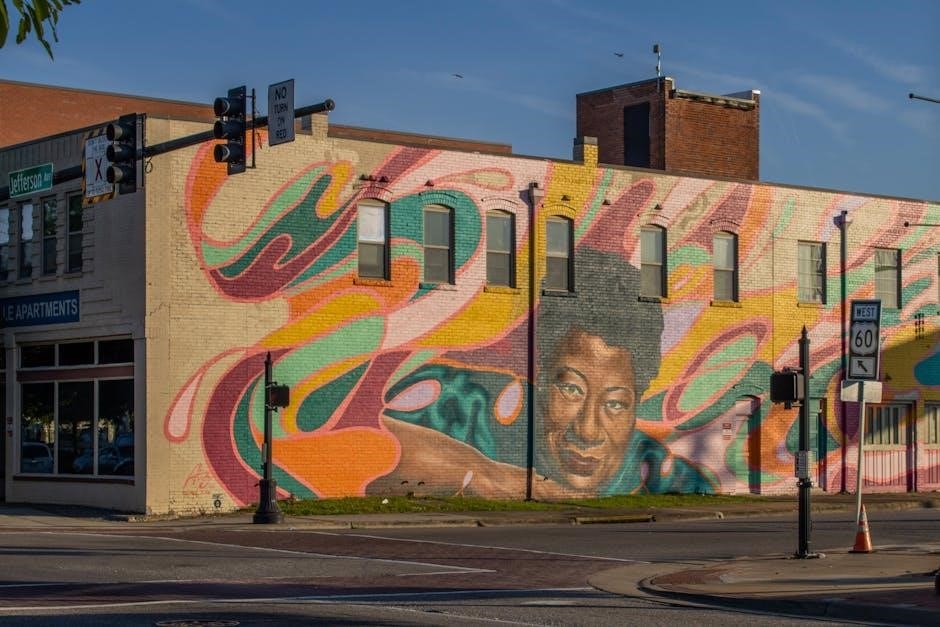Edward Albee’s play, first performed in 1962, is available as a PDF. It explores marriage dynamics and illusion versus reality through intense dialogue and dark humor.

1.1 Overview of the Play
Edward Albee’s Who’s Afraid of Virginia Woolf? is a three-act play exploring the dysfunctional marriage of George and Martha. Through dark humor and intense dialogue, the play delves into themes of illusion, reality, and power dynamics. The arrival of a young couple, Nick and Honey, escalates tensions, revealing the cracks in both relationships. Albee’s absurdist style critiques societal norms, making the play a landmark of modern theater. Its raw emotional depth continues to captivate audiences and scholars alike.
1.2 Historical Background and Context
Who’s Afraid of Virginia Woolf? was written by Edward Albee in 1962, during a period of social change in America. The play reflects the era’s questioning of societal norms, marriage, and academia. Influenced by the absurdist movement, Albee critiques the illusion of the “American Dream.” Its raw dialogue and exploration of human frailty caused controversy but also earned acclaim. The play’s PDF versions are widely available, making it accessible for study and analysis, ensuring its relevance in modern academic discussions.
1.3 Edward Albee’s Contribution to Theater
Edward Albee revolutionized theater with his absurdist plays, including Who’s Afraid of Virginia Woolf?. His work challenged traditional narratives, exploring themes of illusion and reality. The play’s intense dialogue and dark humor set a new standard for dramatic storytelling. PDF versions of the play are widely available, allowing scholars to study Albee’s innovative techniques. His contributions remain significant, influencing contemporary theater and ensuring his legacy as a master of modern drama.

Main Characters and Their Roles
The play revolves around George, Martha, Nick, and Honey, exploring their complex relationships and emotional struggles. Their interactions reveal deep-seated conflicts and societal critiques.
2.1 George and Martha: The Central Couple
George and Martha are the volatile center of the play, engaging in verbal sparring and emotional manipulation. Their relationship is marked by a toxic mix of love and resentment. Martha, the daughter of the university president, and George, a history professor, struggle with their public personas versus private realities. Their interactions reveal deep-seated insecurities and the illusion of their son, symbolizing their failed aspirations and fractured marriage. Their dynamic critiques societal expectations and the illusions that sustain relationships.
2.2 Nick and Honey: The Young Couple
Nick and Honey, a young, ambitious couple, are invited to George and Martha’s home. They represent societal ideals of youth and success, contrasting the older couple’s disillusionment. Their interactions reveal their own insecurities and superficiality. Honey’s naivety and Nick’s pragmatism highlight their struggle to maintain a perfect facade. Their presence escalates the tension, exposing the cracks in their marriage and the illusions they cling to, mirroring the larger themes of the play’s critique of societal expectations and marital dynamics.
2.3 The Significance of the Son
The son in the play serves as a metaphor for George and Martha’s failed aspirations and emotional voids. He is an illusion they maintain to cope with their childlessness and societal expectations. The son symbolizes the idealized version of their marriage and the American Dream they strive to portray. Throughout the play, the son’s “existence” is central to their games of deception, but his eventual “death” reveals the fragility of their illusions, exposing the raw truth of their relationship and the emptiness of their lives.

Themes and Motifs in the Play
The play explores themes of illusion vs. reality, power dynamics in relationships, and a critique of the American Dream, revealing raw human truths beneath societal facades;
3.1 Illusion vs. Reality

The play delves into the tension between illusion and reality, as characters like George and Martha blur the lines through false narratives and emotional games. Their interactions reveal how illusions mask true identities and relationships, creating a distorted reality. The PDF versions highlight Albee’s use of dialogue to expose this duality, showing how characters hide behind societal expectations and fabricated truths, ultimately revealing the fragility of their emotional constructs.
3.2 Power Dynamics in Relationships
The play examines the shifting power dynamics between George and Martha, showcasing their volatile relationship. Through verbal sparring and emotional manipulation, they constantly renegotiate control. Martha uses her dominance to provoke George, while he counters with passive-aggressive tactics. Their interactions reveal a cycle of vulnerability and aggression, highlighting how power is both asserted and undermined. The PDF versions emphasize Albee’s exploration of these dynamics, illustrating how societal roles and personal insecurities fuel their struggles for dominance and emotional validation.
3.3 The American Dream and Its Critique
Edward Albee’s play critiques the American Dream through George and Martha’s disillusionment with societal expectations. The illusion of a perfect marriage and academic success is contrasted with their emotional emptiness. Martha’s dominance and George’s passive resistance reflect the struggle against gender and social roles. The play challenges the notion of a flawless life, exposing the cracks in the American Dream’s promises. PDF versions highlight Albee’s critique, emphasizing how the pursuit of societal ideals leads to personal dissatisfaction and emotional turmoil.

Structure and Style of the Play
Albee’s play follows a three-act structure, blending realistic dialogue with dark humor. The tension escalates through verbal sparring and emotional revelations, showcasing the characters’ psychological complexity and relational dynamics.
4.1 The Three-Act Structure
Edward Albee’s Who’s Afraid of Virginia Woolf? follows a three-act structure, each advancing the psychological tension and emotional conflict. Act One introduces George and Martha’s toxic relationship, setting the stage for their verbal sparring. Act Two escalates the conflict, revealing deeper truths about their marriage and illusions. Act Three brings resolution, stripping away facades to expose raw truths. This structure effectively builds dramatic intensity, exploring themes of illusion, reality, and the disintegration of the American Dream through layered dialogue and dark humor.
4.2 Language and Dialogue
Albee’s masterful use of language in Who’s Afraid of Virginia Woolf? creates a sharp, biting dialogue that reflects the characters’ emotional complexity. The conversations are laced with sarcasm, irony, and layered meanings, often serving as weapons in George and Martha’s ongoing battle. The dialogue’s rhythmic intensity heightens tension, while its poetic nuances reveal deeper truths about their relationship. This linguistic dexterity not only drives the plot but also underscores the play’s themes of illusion, power dynamics, and the fragility of human connections.
4.3 The Use of Dark Humor
Dark humor in Who’s Afraid of Virginia Woolf? serves as a stark contrast to the underlying emotional pain of the characters. Albee employs witty, cynical remarks and absurd situations to highlight the futility of George and Martha’s relationship. This humor acts as a coping mechanism, masking their despair and fueling their verbal sparring. The interplay of comedy and tragedy creates a unsettling atmosphere, forcing the audience to confront the harsh realities of their unraveling marriage and the illusions they cling to for survival.

Symbolism and Metaphors
The play uses the title, the child, and games like “Get the Guests” as metaphors to explore illusion, power dynamics, and the fragility of human relationships.
5.1 The Title: “Who’s Afraid of Virginia Woolf?”
The title references a song parody, symbolizing the characters’ fears and vulnerabilities. It hints at the blurred lines between reality and illusion, central to the play’s themes. The phrase also reflects the emotional turmoil and power struggles within the characters, particularly Martha and George, as they navigate their dysfunctional relationship. This metaphorical title sets the tone for the exploration of human fragility and the masks people wear.
5.2 The Game of “Get the Guests”
The game “Get the Guests” is a manipulative tactic used by Martha and George to expose their guests’ vulnerabilities. It involves psychological warfare, revealing truths and lies, and blurring reality. This game highlights the couple’s toxic relationship dynamics, using humor and cruelty to dismantle social facades. Through this game, Albee critiques societal pretenses and explores the fragility of human relationships, making it a pivotal element in the play’s dramatic tension and thematic depth.
5.3 The Illusion of the Child
The illusion of the child in Who’s Afraid of Virginia Woolf? is a central metaphor representing George and Martha’s shared fantasy. This imaginary child serves as both a coping mechanism and a weapon in their relationship. It symbolizes their failed dreams, infertility, and emotional emptiness. Through this illusion, Albee critiques societal expectations and the fragility of human relationships. The child’s “death” ultimately shatters the facade, revealing the raw truth beneath their manipulative games and highlighting the destructive power of illusions in sustaining their marriage.

Critical Reception and Reviews
The play initially sparked controversy but received acclaim for its intense dialogue and dark humor, exploring themes of illusion and reality in marriage.
6.1 Initial Reception in 1962
Upon its 1962 debut, Who’s Afraid of Virginia Woolf? sparked controversy due to its explicit language and themes. Critics praised its intense dialogue and psychological depth, while some deemed it provocative. The play won a Tony Award for Best Play, solidifying its impact. Audiences were divided, but its bold exploration of marriage and illusion versus reality marked it as a groundbreaking work in American theater, challenging societal norms and expectations.
6.2 Modern Interpretations and Relevance
Today, Who’s Afraid of Virginia Woolf? remains a timeless exploration of marriage, illusion, and reality. Modern scholars and audiences appreciate its psychological depth and the raw portrayal of human relationships. The play’s critique of societal expectations and power dynamics continues to resonate, making it a staple in theatrical studies. Its themes of identity and deception are as relevant now as they were in 1962, ensuring its enduring impact on contemporary theater and cultural discourse.
6.3 Controversies and Criticisms
Edward Albee’s play has faced criticism for its intense language and themes. Some have accused it of misogyny due to Martha’s portrayal. Others critique its bleak outlook on marriage and life. Despite this, the play’s raw honesty has been praised for sparking necessary conversations about societal norms and human frailty. Its controversial nature has kept it a subject of debate, ensuring its relevance in modern theatrical discourse.

Adaptations and Performances
The play was adapted into a 1966 film starring Richard Burton and Elizabeth Taylor. It has also had numerous stage productions, ensuring its lasting theatrical impact.
7.1 The 1966 Film Adaptation
The 1966 film adaptation of Who’s Afraid of Virginia Woolf? was directed by Mike Nichols and starred Richard Burton and Elizabeth Taylor. It remained faithful to Edward Albee’s play, capturing the intense dynamics between George and Martha. The film won several Academy Awards, solidifying its place as a landmark cinematic achievement. Its success highlighted the timeless relevance of Albee’s exploration of marital conflict and illusion. The adaptation is celebrated for its raw emotional depth and loyalty to the original text.
7.2 Notable Stage Productions
Notable stage productions of Who’s Afraid of Virginia Woolf? include a 2014 production at the Theater Yunogo Zritelya, directed by Kama Ginkas. This adaptation highlighted the play’s emotional intensity and dark humor, drawing critical acclaim for its faithful interpretation of Albee’s text. The production emphasized the complex dynamics between George and Martha, showcasing the playwright’s exploration of marital dysfunction and illusion. It remains a significant example of the play’s enduring theatrical relevance and impact.
7.4 Cultural Impact and Legacy
Who’s Afraid of Virginia Woolf? has left a profound cultural impact. Its exploration of marriage, illusion, and reality resonated widely, influencing both theater and literature. The play’s PDF availability has made it accessible for academic study, ensuring its themes remain relevant. Albee’s work continues to inspire new adaptations and scholarly discussions, solidifying its legacy as a cornerstone of modern drama and a critique of societal norms, particularly the American Dream.

Educational Resources and Availability
PDF versions of Who’s Afraid of Virginia Woolf? are widely available online, along with study guides and analyses, making it accessible for educational purposes and scholarly research.
8.1 PDF Versions and Digital Access
PDF versions of Who’s Afraid of Virginia Woolf? are readily available online, including through platforms like eBook Galleries and academic databases. These digital versions provide easy access to the play, enabling readers to study and analyze Albee’s work. Many editions, such as the 1963 New York publication, are widely distributed, making the play accessible for educational purposes and scholarly research. Digital access has enhanced the play’s reach, allowing global audiences to engage with its themes and complexity.
8.2 Study Guides and Analysis
Study guides and analyses of Who’s Afraid of Virginia Woolf? are available in PDF formats, offering in-depth insights into the play’s themes, characters, and literary devices. These resources often include summaries, critical essays, and discussion questions, helping readers understand the complexities of George and Martha’s relationship. Many guides focus on Albee’s exploration of illusion vs. reality, power dynamics, and the critique of the American Dream. They are valuable tools for students and scholars analyzing the play’s dramatic structure and cultural significance.
8.3 Academic Discussions and Essays
Academic discussions and essays on Who’s Afraid of Virginia Woolf? are widely available in PDF formats, offering scholarly insights into the play’s themes and motifs. These essays often analyze the dynamics between George and Martha, the illusion of the child, and the critique of the American Dream. Scholars like Sanjana Santra and Olga Mymrina provide critical perspectives, while others explore Albee’s use of language and dark humor. These resources are invaluable for deeper understanding and academic research.
Edward Albee’s Who’s Afraid of Virginia Woolf? remains a powerful exploration of illusion, reality, and human relationships. Its themes and dark humor continue to resonate, with PDF versions and essays ensuring its academic and cultural relevance endures.
9.1 The Enduring Significance of the Play
Edward Albee’s Who’s Afraid of Virginia Woolf? remains a landmark in modern theater, exploring themes of illusion, reality, and marital dysfunction. Its raw dialogue and dark humor continue to captivate audiences, making it a timeless critique of societal norms and human frailty. Available in PDF formats and studied globally, the play’s enduring relevance lies in its ability to provoke reflection on truth, power, and the American Dream, ensuring its place in both academic and cultural discourse.
9.2 Final Thoughts on “Who’s Afraid of Virginia Woolf?”
Edward Albee’s masterpiece challenges audiences to confront uncomfortable truths about relationships and identity. Through George and Martha’s toxic dynamic, the play strips away societal facades, revealing raw human vulnerability. Available in PDF, its themes of illusion, power, and the fractured American Dream resonate deeply. Albee’s work remains a powerful exploration of human complexity, ensuring its lasting impact on theater and literature. Its ability to provoke thought and emotion solidifies its place as a modern classic.
